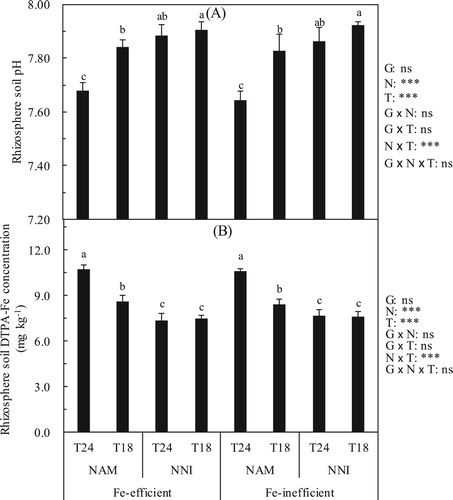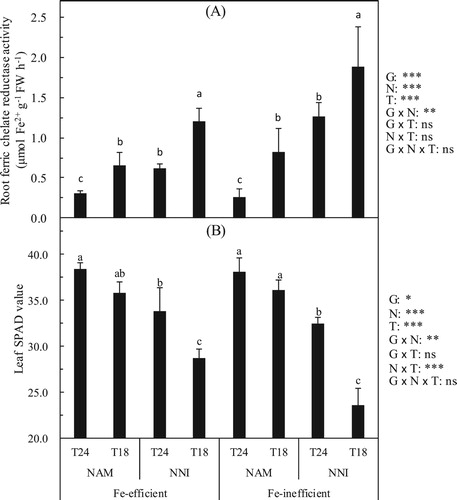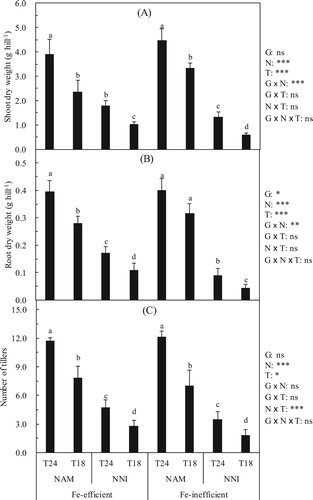Figures & data
Figure 1. Effect of nitrogen forms (N) on rhizosphere soil pH (A) and rhizosphere soil DTPA-Fe (B) of rice cultivars (G) in different soil temperatures (T). Error bars represent SE (n = 4). Columns within each cultivar the same letter are not significantly different at 5% according to Duncan’s multiple range test. Abbreviations: Fe-efficient and Fe-inefficient, Fe-efficient genotype rice (O. sativa L. cv. T43) and Fe-inefficient genotype rice (O. sativa L. cv. T04). NAM and NNI, ammonium nitrogen was (NH4)2SO4 + 2.0% DCD and nitrate nitrogen was Ca(NO3)2 + 2.0% DCD, respectively. T24 and T18, soil optimum temperature was 24 ± 2°C and soil low temperature was 18 ± 2°C, respectively. *** and ns indicate significant differences at p < 0.1% and p ≥ 5%.

Figure 2. Effect of nitrogen forms (N) on root ferric chelate reductase activity (A) and leaf SPAD value (B) of rice cultivars (G) in different soil temperatures (T). Error bars represent SE (n = 4). Columns within each cultivar the same letter are not significantly different at 5% according to Duncan’s multiple range test. Abbreviations: Fe-efficient and Fe-inefficient, Fe-efficient genotype rice (O. sativa L. cv. T43) and Fe-inefficient genotype rice (O. sativa L. cv. T04). NAM and NNI, ammonium nitrogen was (NH4)2SO4 + 2.0% DCD and nitrate nitrogen was Ca(NO3)2 + 2.0% DCD, respectively. T24 and T18, soil optimum temperature was 24 ± 2°C and soil low temperature was 18 ± 2°C, respectively. *, **, *** and ns indicate significant differences at P < 5%, P < 1%, p < 0.1% and p ≥ 5%.

Figure 3. Effect of nitrogen forms (N) on shoot dry weight (A), root dry weight (B) and number of tillers (C) of rice cultivars (G) in different soil temperatures (T). Error bars represent SE (n = 4). Columns within each cultivar the same letter are not significantly different at 5% according to Duncan’s multiple range test. Abbreviations: Fe-efficient and Fe-inefficient, Fe-efficient genotype rice (O. sativa L. cv. T43) and Fe-inefficient genotype rice (O. sativa L. cv. T04). NAM and NNI, ammonium nitrogen was (NH4)2SO4 + 2.0% DCD and nitrate nitrogen was Ca(NO3)2 + 2.0% DCD, respectively. T24 and T18, soil optimum temperature was 24 ± 2°C and soil low temperature was 18 ± 2°C, respectively. *, **, *** and ns indicate significant differences at P < 5%, P < 1%, p < 0.1% and p ≥ 5%.

